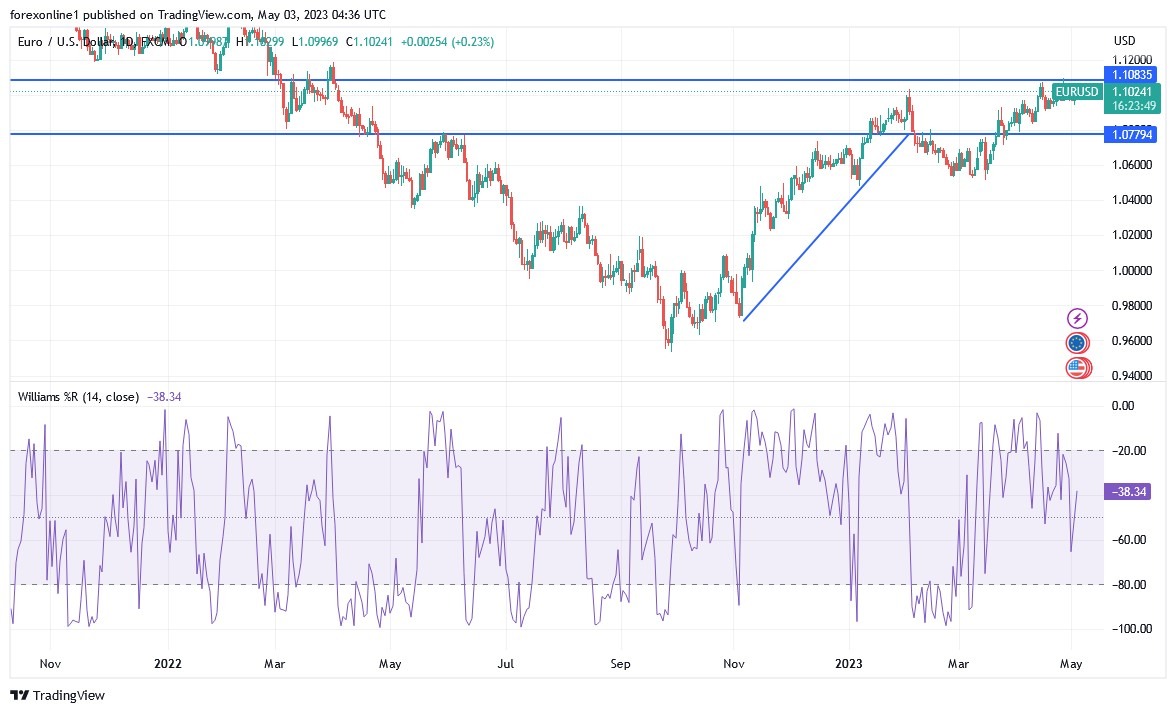The price of the EUR/USD currency pair was exposed to selling operations with losses that affected the support level 1.0942, and returned at the beginning of trading today, Wednesday. It tested the psychological resistance level 1.1000 to stop further collapse, as inflation figures in the euro zone showed momentum for the future of tightening policy.
European inflation rose in April for the first time since September, but a closely watched core inflation measure fell in a Eurostat report that has uncertain implications for the European Central Bank's (ECB) monetary policy ahead of Thursday's interest rate decision. According to the official announcement, inflation rose from 6.9% to 7% last month, in line with the consensus of economists, after food, alcohol and tobacco prices rose sharply in the month to reinforce the impact of increases in the cost of non-energy industrial goods, which led to a six-month outage with a decrease in the general measure of inflation.
Inflation has fallen steadily since September 2022, but the higher tick mark has been caused by changes in volatile commodities and regulated price components, so the implications of Thursday's European Central Bank interest rate decision are far from clear, and even more so than a figure. Inflation in light of the essence. Core inflation, which excludes energy, food and regulated price items from a basket of measured goods, fell from 5.7% to 5.6% last month.
This was also in line with economists' expectations and may be enough to prevent the European Central Bank from continuing to raise interest rates on Thursday by significant half-percentage-point increments since it began raising borrowing costs in July last year. The consensus among economists is that Thursday is likely to see the European Central Bank shift to a lower path by raising interest rates charged or paid on commercial bank deposits or loans by a quarter of a percentage point smaller, bringing the negative deposit rate back up again. one to 3.25%.
This means that the ECB has raised borrowing costs for banks, businesses, and households by a total of 375 basis points, or 3.75%, as part of its efforts to ensure inflation returns to its identical target of 2%. The overall decision and outlook on interest rates remains uncertain, but below are observations by analysts and economists in Europe and elsewhere that show how they see ECB policy unfolding as the year goes on.
Analysts at Nordea Markets, "Service price inflation has increased marginally while commodity price inflation has eased, giving a somewhat more worrying tendency for core inflation since service prices are where the wage component is largest." And “Also, although unprocessed food price inflation has declined, overall food price inflation has remained very high.”
They added, "Inflation remains very high, and while the underlying effects from last year's energy price increases will drive down core inflation in the coming months, core inflation remains a major concern in the ECB's economic outlook." They added, “While the economic outlook is weak, core inflation remains very high and will keep the ECB in hiking mode for the time being. We see +25bps with hawkish comments on Thursday."
According to ING Bank analysts, “This makes April inflation in the eurozone sticky and confirms the need for more price increases, albeit at a slower pace and smaller volume than before.” Looking ahead, inflation developments in the eurozone will be determined by two opposing forces: on the one hand, negative fundamental effects on energy and food prices combined with lower expectations of selling prices in industry are driving a further decline in headline inflation.
On the other hand, expectations of higher selling prices in services as well as increases in wages are likely to increase underlying inflationary pressures. As a result, we expect core inflation to continue to decline, while core inflation will remain flat.” "The only question is whether the ECB will go with 25 basis points or 50 basis points," they added. In public, only Austrian Central Bank Governor Robert Holzmann was in favor of 50 basis points. Other hawks, such as Isabel Schnabel, recently left the 50 basis point option but have not formally signed up to it. “The flat inflation data clearly underscores the need to continue rising but with the weaker-than-expected GDP growth report last week and weak loan and loan demand growth data today, the case for the slowdown in the pace of rate hikes is becoming stronger. We're sticking to our call for a 25 basis point rate hike on Thursday."
Euro predictions against the dollar today:
- There is no change in the performance of the price of the EUR/USD currency pair.
- The move around and above the psychological resistance 1.1000 will continue to support the bulls in more control over the performance of the EUR/USD.
- The next peaks, if this happens, will be 1.1065 and 1.1120, respectively.
- It will depend on the tightening path of both the European Central Bank and the US Federal Reserve.
According to the performance on the daily chart, the bears will move towards the support level 1.0920, which is less important for the general trend to turn bearish. The currency pair will be greatly affected today by the policy update of the US Federal Reserve and the statements of its Governor, Jerome Powell.
Ready to trade our daily Forex analysis? We’ve made a list of the best forex trading accounts worth trading with.


